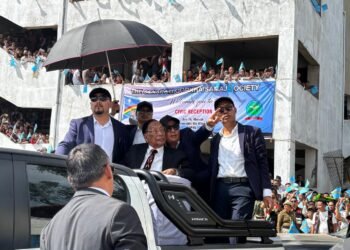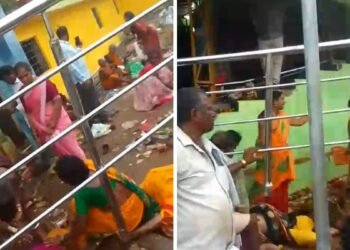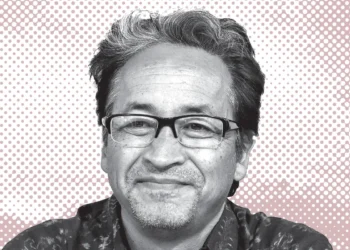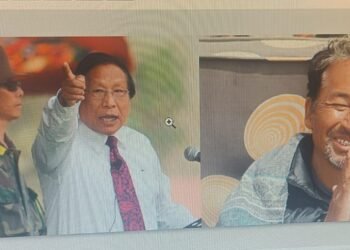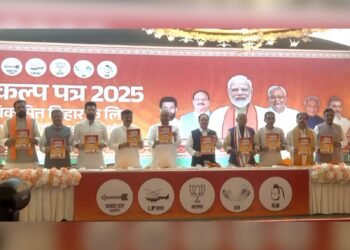By claiming India had already “acknowledged Naga sovereignty,” Th. Muivah positioned the NSCN-IM not as rebels but as co-sovereigns. His warning to Delhi — “Nagalim may once again be forced onto the battlefield” — underlines how volatile the peace process remains.
BY Navin Upadhyay
November 1, 2025 — In the Naga-dominated hill districts of Manipur, a 91-year-old rebel leader has delivered two of the most explosive speeches in recent Indian history.
Thuingaleng Muivah, the general secretary of the National Socialist Council of Nagalim (Isak-Muivah), or NSCN-IM, stood before thousands in Ukhrul on October 22 and again in Senapati on October 29, openly calling for Naga secession from India.
He once again invoked the demand for a separate flag, a separate constitution, and a political settlement “outside the Union and Constitution of India.” Yet, as Muivah’s words echoed across the valleys, New Delhi remained silent. No sedition charges. No arrests. No official rebuttal. Just the quiet hum of a fragile 28-year peace process hanging by a thread.
A Homecoming — Then a Declaration of War
Muivah had not set foot in his birthplace, Somdal village in Ukhrul, in over five decades. When he finally returned on October 22, the moment was electric. Thousands lined the mountain roads. Church bells rang. Elderly women in traditional shawls wept.
The man who once commanded guerrilla armies from jungle camps in Myanmar and Thailand was now back on native soil — frail in body but unyielding in conviction.
At the Tangkhul Naga Long ground, he wasted no time. “Nagalim was never a part of India, either by consent or by conquest,” he declared, his voice steady despite age. “The ‘new relationship’ shall be concluded outside the Union and Constitution of India and Myanmar.”
He invoked the 2015 Framework Agreement — signed in the presence of Prime Minister Narendra Modi — as proof that India had already acknowledged Naga sovereignty. “Sovereignty lies with the people,” he said, quoting the document.
“We also inform the leadership of India that, whether today or tomorrow, whether in heaven or on earth, the Naga national flag and Naga national constitution are non-negotiable. We also want to make it clear to the GoI that the NSCN/GPRN does not recognize any other so-called agreements signed by the GoI with some factions to duplicate and sabotage the letter and spirit of the Amsterdam Joint Communiqué and the Framework Agreement,” he said.
Any Naga who accepted a settlement within the Indian Constitution, he warned, would be branded a traitor. The crowd, many waving the outlawed Naga flag, erupted in applause.
Warning New Delhi on waging another round of armed rebellion, he said, “ At this point in time, I wish to inform the Nagas and the international community again that India and Burma (Myanmar) may once again force Nagalim onto the battlefield. Then we shall continue to fight a war of liberation and resistance against the occupational forces in self-defense. Nagalim and the Naga people must be sufficiently informed that Nagalim’s freedom will not come as a free gift, but Nagas must be prepared and ready to defend their freedom.”
Muivah seeks forgiveness as he muttered on his maiden visit to his birthplace in Manipur.
Looks like he has lost most of his ability.
With NPF in tight grip by Nagas of Nagaland, NNPG already settled the issue, a new stage is being set. https://t.co/fbQtNz7WJg pic.twitter.com/bnvOj6Q6UW— Pukning (@PukningWarol) October 29, 2025
Seven Days Later: The Message Hardens
If Ukhrul was a homecoming, Senapati was a battle cry.
On October 29, Muivah addressed an even larger gathering from the southern Naga regions — Shepoumaramth, Wung Tangkhul, Mao, Maram, and beyond.
He began with a prayer in the name of Jesus Christ, then launched into a roll call of martyrs: Haipou Jadonang, hanged by the British in 1931; Naga students shot dead in 1948; two young scholars gunned down in 2010 while trying to welcome him home.
Then came the core demand, delivered with chilling clarity:
“Nagalim shall be sovereign in all matters of her own affairs. The sharing of sovereign powers between two sovereign entities makes it crystal clear — Nagalim is outside the Union and Constitution of India.”
He rejected every past accord signed within India’s legal framework. “The NSCN does not recognize any agreement within the Constitution of India — past, present, or future,” he said. “The only acceptable solution will recognize Nagalim sovereignty, Nagalim territory, the Naga national flag, and the Naga national constitution.”
Muivah accused the Indian state of using the Armed Forces (Special Powers) Act, or AFSPA, as a tool of “state terrorism” since 1958 — a law, he said, that had turned Nagaland into a laboratory of impunity. He cited the 2021 Oting massacre, where 14 civilians were killed by security forces, as evidence that “Nagas have always been the target practice.”
“The Naga people across Nagalim,” said Muivah, “have lived under military rule imposed by India and Myanmar. For decades, our people have suffered unspeakable violations — rapes, torture, disappearances, and the burning of villages and churches. Entire communities were forced into concentration camps, starved, and treated as enemies in their own land.”
He cited the rape of four girls at Yankeli Baptist Church in 1971 and the case of 19-year-old Rose from Ukhrul, who took her own life after being assaulted by two BSF officers in 1974. Such atrocities, Muivah said, were not isolated but part of a “systematic counter-insurgency pogrom to annihilate the Naga nation.”
Muivah referred to fact-finding reports by the Naga People’s Movement for Human Rights and books such as Nagaland File: Question of Human Rights by Luingam Luithui and Nandita Haksar, and The Judgement That Never Came by Haksar and Sebastian Hongray, which documented decades of military excesses.
He also condemned the Supreme Court’s 2023 decision to close all FIRs against 21 Para Special Forces personnel involved in the 2021 Oting massacre, calling it “proof of blanket impunity” under the continuing Armed Forces (Special Powers) Act.
“Not a single Indian civilian has been harmed by Nagas in 79 years of conflict,” he claimed. “Yet Nagalim has been bombed, burned, and brutalized for decades.”
READ: TIME Names Wangchuk Among Top 100 Climate Leaders — He Reads It Behind Bars
READ: Two Frontiers, Two Standards: Secessionist Muivah Feted, Wangchuk Jailed for… Peace?
Why No Action?
Muivah’s speeches were not clandestine. They were live-streamed on social media, recorded by local journalists, and shared widely across Naga communities.
They violated multiple laws — Section 124A (sedition), restrictions on speech under Article 19(2), and the terms of the ceasefire agreement itself, which bars “propaganda against the sovereignty of India.”
So why has the government looked the other way?
The answer lies in the fragile architecture of the Indo-Naga peace process. The 1997 ceasefire, extended indefinitely, prohibits military action but allows “political expression.”
Muivah’s visits were not merely tolerated — they were quietly facilitated by the Centre, as well as the Nagaland and Manipur governments. Roads were cleared, security escorts arranged, and permissions granted under the banner of “peace and dialogue.”
The 2015 Framework Agreement, still secret, remains the elephant in the room.
Signed in Modi’s presence and hailed as a “historic step,” it contained ambiguous phrases — “unique history,” “sovereignty lies with the people,” “sharing of sovereign power” — that Muivah now interprets as India’s tacit recognition of Naga independence. Delhi, however, insists it meant autonomy within India, not outside it.
Neither side has ever released the full text. Confronting Muivah publicly would force the government to explain — or contradict — its own words.
Manipur’s Calculated Silence
In Manipur, the state administration under Governor AK Bhalla, finds itself walking a tightrope.
The state has been torn apart by two years of Meitei–Kuki ethnic violence, with hundreds dead and thousands displaced. The hills remain tense, the valley resentful, and the trust between communities shattered.
Cracking down on Muivah’s speech could inflame the tribal hills, where sympathy for the Naga cause still runs deep. Ignoring him, on the other hand, risks emboldening secessionists. With Assembly elections due in 2027, the BJP-led government has little appetite for a new front of insurgent hostility
At the same time, for New Delhi, Muivah’s rhetoric is both a provocation and a paradox.
After nearly three decades of ceasefire, the NSCN-IM leadership remains armed, defiant, and deeply entrenched. Yet, India’s own policy has been one of cautious tolerance — keeping dialogue channels open while quietly containing militant capacity.
It’s a silence rooted not in fear, but in political calculation. Delhi knows that one wrong move could unravel years of backchannel negotiations. And as long as Muivah stays within the rhetorical battlefield, the government seems willing to let him speak.
A Fragile Faith in Dialogue
Behind the fiery speeches lies a deeper tragedy: the slow death of faith in dialogue.
Since the NSCN split in the late 1980s, multiple factions have emerged — some aligned with Delhi, others bitterly opposed.
The Framework Agreement, once hailed as the end of Asia’s longest insurgency, has turned into a symbol of ambiguity. Neither side trusts the other enough to seal the deal.
Muivah’s tone now suggests a man preparing for legacy, not reconciliation. At 91, frail and partially wheelchair-bound, he remains revered among the Tangkhul Nagas as both prophet and patriot. To many in the valley, however, he is a dangerous relic of another era.
Still, his voice carries weight. For a generation that grew up under AFSPA and militarization, his message of sovereignty resonates as an unfinished dream.
A Warning to Delhi
Muivah ended both speeches with the same line from Scripture:
“If God is for us, who can be against us?” — Romans 8:31.
Then came his secular warning:
“India is deliberately forcing Nagalim back to the battlefield through betrayal and division. We are prepared to face any challenge — on the negotiating table or in the jungle.”
For now, Delhi’s response remains one of strategic restraint. But as the winter fog settles over the Naga hills, the question grows louder:
How long can India afford to tolerate open secessionism — even in the name of peace?



